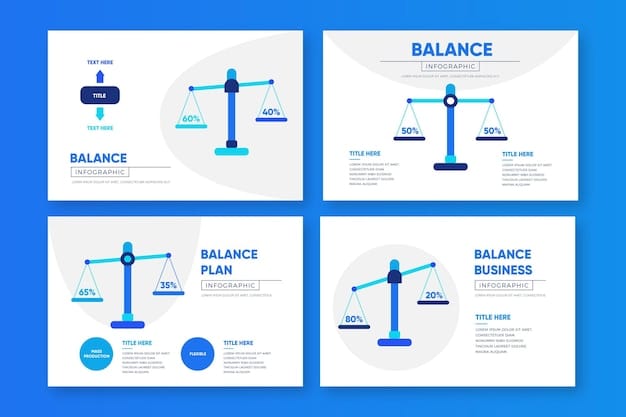Mergers & Acquisitions: Growth Opportunities and Expansion Strategies

Mergers and acquisitions (M&A) are strategic transactions where companies combine to enhance market position, achieve synergies, expand into new markets, or acquire new technologies, necessitating careful evaluation of opportunities and potential risks for successful growth and expansion.
In today’s dynamic business environment, understanding mergers and acquisitions: evaluating opportunities for growth and expansion is crucial for companies looking to stay competitive and achieve sustainable growth. These strategic transactions can unlock significant value, but they also come with inherent risks that must be carefully considered.
Understanding Mergers and Acquisitions
Mergers and acquisitions (M&A) represent transformative events in the corporate world, involving the consolidation of companies to achieve strategic objectives. A merger combines two companies into a single new entity, while an acquisition involves one company purchasing another. Both strategies can significantly alter the competitive landscape and drive growth.
Understanding the nuances of M&A is crucial for businesses aiming to expand their market presence, enhance operational efficiency, and gain access to new technologies or talent. However, successful M&A requires a thorough evaluation of potential opportunities and risks.
Types of Mergers
Mergers can be categorized into several types based on the relationship between the merging companies. Understanding these types can help businesses identify the right strategic fit.
- Horizontal Merger: This involves companies in the same industry merging to increase market share and reduce competition.
- Vertical Merger: This occurs when companies at different stages of the supply chain merge to improve efficiency and control.
- Conglomerate Merger: This involves companies in unrelated industries merging to diversify their business portfolio.
- Market Extension Merger: This expands a company’s reach into new geographic markets..
Each type of merger presents unique opportunities and challenges, requiring tailored strategies to ensure successful integration and value creation.
In conclusion, understanding the types of mergers is crucial for businesses seeking strategic growth and expansion. Each type offers distinct advantages and challenges, requiring careful consideration and planning to achieve desired outcomes.
Strategic Objectives of M&A
Mergers and acquisitions are driven by various strategic objectives, each aimed at enhancing the acquirer’s competitive position and long-term growth prospects. Identifying and aligning M&A activities with these objectives is crucial for achieving desired outcomes.
Companies engage in M&A to achieve a range of strategic goals, including expanding market share, enhancing operational efficiencies, and acquiring new capabilities. These objectives are pivotal in guiding the M&A process and ensuring value creation.

Market Expansion
One of the primary drivers of M&A is to expand into new geographic markets or customer segments. This can provide access to new revenue streams and reduce reliance on existing markets.
Synergy Creation
M&A can lead to significant synergies through cost reduction, revenue enhancement, and operational improvements. These synergies are a key factor in justifying the investment in an M&A transaction.
In summary, aligning M&A activities with clear strategic objectives is essential for achieving long-term growth and success. By understanding and focusing on these goals, companies can maximize the value generated from their M&A transactions.
Evaluating Opportunities: Due Diligence
Due diligence is a critical step in the M&A process, involving a comprehensive investigation of the target company to assess its financial health, operational performance, compliance, and potential risks. Thorough due diligence is essential for making informed decisions and negotiating favorable terms.
The due diligence process aims to uncover any hidden liabilities, assess the target’s assets, and validate its business model. This rigorous evaluation helps the acquirer understand the true value and potential risks associated with the transaction.
Comprehensive due diligence is crucial for mitigating risks and ensuring a successful M&A transaction. By thoroughly evaluating the target company, acquirers can make informed decisions and avoid costly surprises. This process involves assessing financial statements, operational performance, legal compliance, and market conditions.
- Financial Due Diligence: Assessing the target’s financial statements, including balance sheets, income statements, and cash flow statements.
- Operational Due Diligence: Evaluating the target’s operational efficiency, processes, and technology.
- Legal Due Diligence: Reviewing legal contracts, compliance with regulations, and potential liabilities.
- Market Due Diligence: Analyzing the target’s market position, competition, and growth opportunities.
A well-executed due diligence process provides a solid foundation for negotiation and integration, ultimately contributing to a successful M&A outcome.
Valuation Methods in M&A
Accurate valuation is a cornerstone of successful M&A transactions. Determining the fair market value of the target company is essential for negotiating a reasonable purchase price and ensuring a positive return on investment.
Several valuation methods are commonly used in M&A, each with its strengths and limitations. Understanding these methods helps in arriving at a well-informed valuation and structuring the deal effectively.
Discounted Cash Flow (DCF)
DCF analysis involves projecting the target’s future cash flows and discounting them back to their present value using an appropriate discount rate.
Comparable Company Analysis
This method involves comparing the target’s financial metrics to those of similar companies that have been recently acquired or are publicly traded.

Precedent Transaction Analysis
This involves analyzing past M&A transactions in the same industry to determine the multiples paid for similar companies.
- Asset Valuation: Determines the value of tangible and intangible assets.
- Market Conditions: Reflects current economic and industry-specific factors.
- Synergy Potential: Estimates the value created through combined operations.
In conclusion, accurate valuation is critical for successful M&A transactions. By employing various valuation methods and considering key factors, acquirers can arrive at a fair purchase price and maximize their return on investment.
Integration Planning and Execution
Post-merger integration (PMI) is a critical phase in the M&A process, focused on combining the operations, cultures, and systems of the merging companies to achieve the expected synergies and strategic objectives. Effective integration planning and execution are essential for realizing the full potential of the M&A transaction.
PMI requires a structured approach, involving careful planning, clear communication, and strong leadership to navigate the complexities of combining two organizations. Successful integration can lead to significant cost savings, revenue enhancements, and improved market position.
Effective post-merger integration (PMI) is essential for achieving the anticipated benefits of an M&A transaction. This involves aligning operations, cultures, and systems to create a cohesive and efficient organization. Key steps include:
- Integration Planning: Developing a detailed plan that outlines the integration process, timelines, and responsibilities.
- Cultural Integration: Addressing cultural differences and fostering a shared vision and values.
- Operational Integration: Streamlining processes, systems, and technology to improve efficiency.
- Communication and Change Management: Keeping employees informed and engaged throughout the integration process.
A well-executed PMI process enhances employee morale, reduces disruptions, and accelerates the realization of synergies. It sets the stage for a successful and sustainable combined organization.
Risk Management in Mergers and Acquisitions
Mergers and acquisitions involve inherent risks that can impact the success of the transaction. Effective risk management is crucial for identifying, assessing, and mitigating potential challenges throughout the M&A process.
Risks can arise from various sources, including financial, operational, legal, and cultural factors. Implementing robust risk management strategies helps in safeguarding the investment and achieving the desired outcomes.
Effective risk management is crucial in M&A to mitigate potential challenges and ensure a successful transaction. This involves identifying, assessing, and mitigating financial, operational, and legal risks. Key strategies include:
- Financial Risk Management: Assessing the target’s financial stability, debt levels, and potential liabilities.
- Operational Risk Management: Evaluating operational inefficiencies, integration challenges, and market risks.
- Legal and Compliance Risk Management: Ensuring compliance with regulations, contracts, and legal obligations.
- Cultural Risk Management: Addressing cultural differences and fostering a positive work environment.
By proactively managing these risks, companies can minimize potential disruptions, protect their investment, and enhance the likelihood of a successful M&A outcome.
| Key Aspect | Brief Description |
|---|---|
| 🚀 Strategic Objectives | M&A aims to expand market share, enhance efficiency, and acquire new capabilities. |
| 🔍 Due Diligence | Thorough investigation of the target company’s financial health and potential risks. |
| 💰 Valuation Methods | Using DCF, comparable company analysis, and precedent transactions to determine fair value. |
| 🧩 Integration Planning | Combining operations, cultures, and systems for synergy and efficiency. |
Frequently Asked Questions
▼
Companies pursue M&A to expand market presence, achieve synergies, acquire new technologies, enhance operational efficiency, and gain a competitive edge. These strategic moves can lead to significant growth and increased profitability.
▼
Due diligence is crucial as it helps uncover potential financial, operational, and legal risks associated with the target company. This process ensures informed decision-making and helps negotiate favorable terms.
▼
Key valuation methods include discounted cash flow (DCF), comparable company analysis, and precedent transaction analysis. These methods help determine the fair market value of the target company.
▼
PMI involves combining the operations, cultures, and systems of the merging companies to achieve synergies and strategic objectives. Effective PMI is crucial for realizing the full potential of the M&A transaction.
▼
M&A transactions involve financial, operational, legal, and cultural risks. Proactive risk management strategies are essential to mitigate these challenges and ensure a successful outcome. Thorough planning is key.
Conclusion
In conclusion, mergers and acquisitions: evaluating opportunities for growth and expansion require a strategic approach, thorough due diligence, accurate valuation, and effective integration planning. By carefully considering these elements, companies can leverage M&A to achieve sustainable growth and enhance their competitive position.





